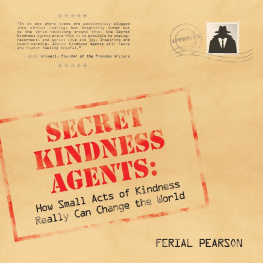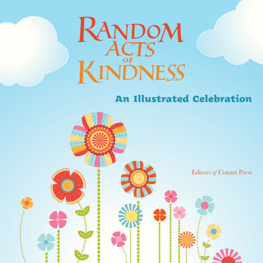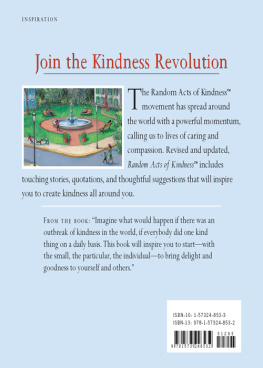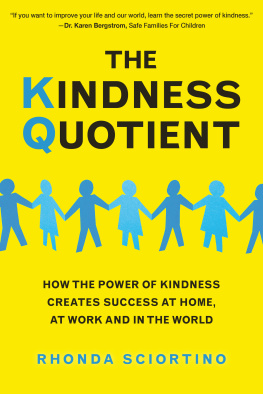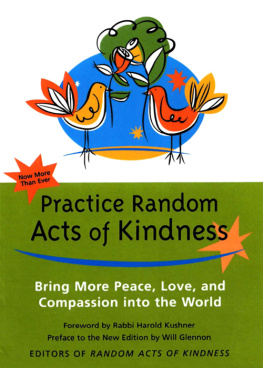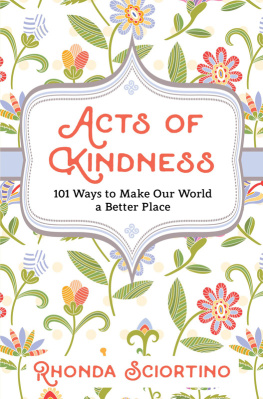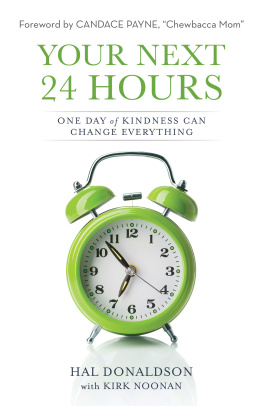SECRET KINDNESS AGENTS:
How Small Acts of Kindness Really Can Change the World
Ferial Pearson
Copyright 2014 by Ferial Pearson
All rights reserved. No part of this book may be reproduced or transmitted in any form or by any means, electronic or mechanical, including photocopying, recording, or by any information storage and retrieval system, without permission in writing from publisher.
Published by WriteLife, LLC
2323 S. 171 St.
Suite 202
Omaha, NE 68130
www.writelife.com
Cover Artwork: Kristy Stark Knapp
ISBN 978-1-60808-108-0
First Edition

In Memoriam
By Sarah Edwards
Emily Dickinson was wrong. Hope is not a thing with feathers. Hope is a verb.
It was in December when Avielle was murdered. At first, I didnt use the word murder because a murder doesnt happen in a space dedicated to math problems and art projects. Murders dont exist in a noisy hallway where friends shout weekend plans and leave behind tiny bits of paper and forgotten pencils. Murder does not belong in a school. Schools hold the promise of our nation. Lives are not taken in a school. My best friends daughter could not possibly be a victim of a school shooting.
Avielle remains in my mind as I last saw her bouncy brown curls that defied control framing her laughing eyes. She was running across a grassy field holding my daughters hand while my son raced after them with a bat and ball. While the adults sat on the porch watching a rumbling thunderstorm pass on the horizon, our kids invented their own version of a baseball game that involved sliding in the mud as often as possible. We talked about how our kids attended such amazing schools. The academics were far beyond what wed learned at their age. The teachers were helping our kids learn how to contribute as part of a community.
Community matters to Avielles parents. Within hours of the shooting, the national community was headed for their front door. We couldnt get there fast enough. As the plane sat on the tarmac waiting to take off, I looked out the window trying to avoid conversation with the man sitting next to me. I didnt want to talk about why I was crying. Minutes into the flight, he handed me his coat and said, Youre shaking. I covered my legs and mumbled an embarrassed, Thank you. Halfway into the flight, I got up the courage to speak and said I was going to Newtown. My best friend lived in Sandy Hook. The rest of the flight we talked in hushed tones, asking questions that had no answers. As we stood to gather our things and leave the plane, I handed him his coat, but the stranger refused to take it. He insisted that I keep it as I continued on my way to Newtown. I remember this random act of kindness from the first few hours after the shooting. The man wanted to do something to help.
Mounds of stuffed teddy bears and a warehouse full of cards attest to a nation, and indeed, a world full of people who felt the need to surround Newtown with a blanket of kindness. Deep within us is the need to respond. Just as the laws of physics teach us that every action has an equal and opposite reaction, this grossly horrific event prompted tens of thousands of people to react in an overwhelming response of hope. Hope is a verb.
Much like the students who acted in this book, we must celebrate opportunities to actively support and assist each other as members of a community. As a teacher, I have dedicated my professional life to building classroom communities; Avielles murder in a school was a personal call to action.
Avielles mother and I were those little girls shouting in the halls forty years ago. We have a lifetime of being friends of the best kind. We value moments like our kids playing in the rain. We celebrate the classrooms that actively hope for change. For Avielles parents, their hope has been forged in a steely resolve to have a conversation around the need for everyone to belong in a community. This means researching brain health and considering how we build a society where every member is a valued part of the whole. Check out the organization for yourself at www.aviellefoundation.org to consider what your hope looks like in action.

Foreword
By Daniel Boster
As a long-time high school teacher, Ive spent a great deal of time reflecting on the lives of schools. It will surprise no one who is a part of the life of a school a teacher, a student, a member of the staff if I were to tell them the days that make up the life of any school are complicated, messy, and hectic. I imagine that even people who dont spend a lot of time in schools are at least vaguely aware of this. But, what people who are on the outside dont often see is that the lives of schools are also often marked by beauty, grace, and quiet moments of inspiration. For every story of violence, abuse, bullying, and tragedy in schools that splash across television news tickers and social media feeds, there are just as many, perhaps more, narratives of hope, resilience, dignity, and, yes, kindness.
I teach at the school where Ferial Pearson and these young Secret Kindness Agents did their work during the 2012-2013 school year. In addition, Im currently teaching them in a literature class during their final year in high school. This brings me to the reason Im so excited that Ferial asked me to contribute a small piece to this project.
To begin, I simply really like all of the folks involved in this project. For them, kindness is not simply a project to be assigned, reflected upon, and dismissed. While Im pretty sure all of them were kind before the tragedy of Sandy Hook and Ferials bringing this idea to them, I do believe that carrying out conscious acts of kindness changed these students. They truly are some of the most considerate students Ive ever worked with. They are gentle in their being and pleasant to be with in a classroom. Now, is this project solely responsible for this? Probably not, but, as their reflections make clear, it did make a difference. They all came to see the value in these small deeds. The smiles that lingered on their faces afterward showed evidence of their joy. They embraced the feeling of having done something good. They allowed themselves to feel empathy and to be vulnerable in acts of service. A project that allows students to accomplish all this can be counted a success. However, thats not all it did.
As you read, one of the items on their initial list of acts to begin the project is Help someone carry a heavy load. Based on what some of the students wrote about, for them, this item was about actually helping someone physically carry something. Of course, this is a nice act of kindness. Yet, as I read this list, my mind kept returning to that simple phrase help someone carry a heavy load. There is no doubt that young people today carry heavy loads. At our school (and most others), the heavy load takes as many forms as there are students. We walk around clearly daunted by these heavy loads that interfere with our ability to learn, to enjoy our lives, to simply be. Often, our burdens seem overwhelming to us. We may even be tempted to give up, to put the heavy load down and walk away.
I like to think that all of the acts these students did the monetary gifts, the kind words, the smiles, the whiteboard cleaning were small steps in the process of lessening those loads. Can these acts erase hardship, cure a school or a society of its ills? Of course not. But, a project like this can make a few young people more conscious of the loads that other people carry and inspire them to take action rather than letting others simply struggle on their lonely paths. I know that they made some of their fellow classmates feel lighter, happier, and better.

